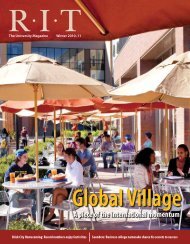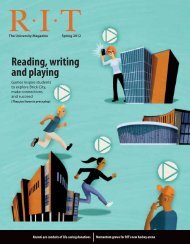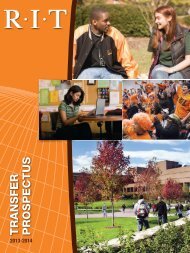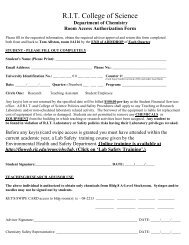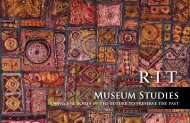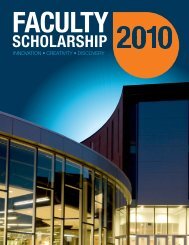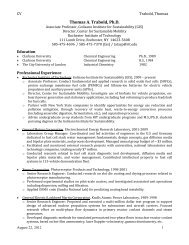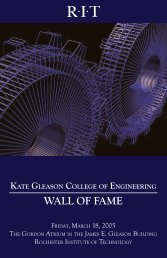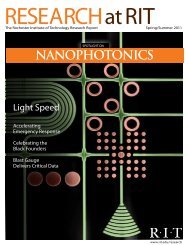Spring / Summer 2013 - Rochester Institute of Technology
Spring / Summer 2013 - Rochester Institute of Technology
Spring / Summer 2013 - Rochester Institute of Technology
Create successful ePaper yourself
Turn your PDF publications into a flip-book with our unique Google optimized e-Paper software.
Related Research<br />
Cisco Systems Establishes<br />
a Research Presence at RIT<br />
<strong>Rochester</strong>’s first Cisco<br />
TelePresence Center was<br />
unveiled in December 2011<br />
at <strong>Rochester</strong> <strong>Institute</strong> <strong>of</strong><br />
<strong>Technology</strong>’s National Technical<br />
<strong>Institute</strong> for the Deaf, enabling<br />
Bill Clymer<br />
high-quality, real-time video<br />
conferencing.<br />
Cisco TelePresence Centers<br />
are located around the world—<br />
including The White House—<br />
and <strong>of</strong>fer high-definition<br />
James DeCaro video conferencing that makes<br />
it seem as though everyone is<br />
seated in the same room, at the same table.<br />
Most are used by executives who find it a less<br />
expensive and more immediate option than<br />
traveling to meetings.<br />
Cisco Systems, headquartered in San Jose,<br />
Calif., donated the equipment, installation, and<br />
engineers to create the customized 14-seat<br />
room at RIT/NTID, ensuring the audio and<br />
lighting match that in other TelePresence<br />
Centers. The TelePresence room, the largest<br />
between Toronto and Albany, is filled with<br />
three 65-inch monitors placed next to each<br />
other. Additional monitors are above the<br />
main monitors and can be used for captioning.<br />
A smaller TelePresence system was also<br />
donated and is based in another location<br />
at RIT/NTID. The donation was made to<br />
RIT/NTID as part <strong>of</strong> a one-year Cisco<br />
research grant funded by Silicon Valley<br />
Community Foundation so that research and<br />
recommendations can be given to Cisco to<br />
help improve its technology to work effectively<br />
for deaf and hard-<strong>of</strong>-hearing individuals.<br />
The bulk <strong>of</strong> the reseach has involved how the<br />
center is best used to accommodate participants<br />
who are deaf or hard <strong>of</strong> hearing to ensure<br />
TelePresence Centers are fully accessible.<br />
The technology enables interpreters to be<br />
miles away from a deaf person attending the<br />
teleconference meeting. The impact could allow<br />
businesses and classrooms to be more inclusive,<br />
especially in areas where sign language<br />
interterpreters may be hard to find. It could<br />
also be used for distance learning programs.<br />
During their research, NTID found it wasn’t<br />
easy to determine where interpreters needed<br />
to be situated in order to be effective and not<br />
obstructive.<br />
Christine Monikowski, a pr<strong>of</strong>essor in NTID’s<br />
American sign language and interpreting<br />
education department, said interpreters<br />
appreciated being part <strong>of</strong> the research process.<br />
“We wanted interpreters to help determine best<br />
TelePresence: RIT, with support from CISCO, is accessing the use <strong>of</strong> the advanced Cisco TelePresence<br />
system so that recommendations can be given to Cisco to help improve its technology to<br />
work effectively for deaf and hard-<strong>of</strong>-hearing individuals. Although the high-resolution visual environment<br />
supports sign language communication, NTID researchers found it wasn’t easy to determine<br />
where interpreters needed to be situated in order to be effective and not obstructive. NTID’s work<br />
continues to ensure that appropriate placement and visual access for the interpreters is optimized.<br />
practices for our field. We needed to actually<br />
have them here to ensure that the data collected<br />
—including appropriate placement and visual<br />
access—was accurate.”<br />
The TelePresence Center also was put to<br />
practical use during the 2012 NTID Job Fair<br />
after Cisco engineer Shraddha Chaplot<br />
suggested attending the fair via TelePresence.<br />
Dozens <strong>of</strong> RIT/NTID students sat at the table<br />
for interviews by Chaplot in California. Cisco<br />
previously hired RIT/NTID students for summer<br />
co-ops in the summer <strong>of</strong> 2011.<br />
After the year <strong>of</strong> planned research ended, a<br />
meeting was held to determine what was learned.<br />
“I can envision the technology used in tutoring,<br />
mentoring, and remote interpreting,” says E.<br />
William Clymer, associate director <strong>of</strong> NTID’s<br />
Center on Access <strong>Technology</strong>. “We envision the<br />
day an interpreter won’t come into this <strong>of</strong>fice, but<br />
would link to a TelePresence Center on a laptop.”<br />
The center at RIT/NTID has enabled<br />
interactions with other universities with similar<br />
technology in India. The technology has also<br />
spurred interest by Gov. Andrew Cuomo and<br />
<strong>of</strong>ficials in Japan who were developing reports<br />
on emergency communications.<br />
“This really ties into our mission,” says James<br />
DeCaro, director <strong>of</strong> the Center on Access<br />
<strong>Technology</strong>. “This is the future. There aren’t going<br />
to be 5,000 students here. It’s us reaching out<br />
to them and our becoming a national center.”<br />
Chaplot, who led the effort on the TelePresence<br />
donation and research grant, said she is<br />
proud <strong>of</strong> Cisco’s partnership with RIT/NTID.<br />
“From the research they did regarding<br />
TelePresence uses for deaf and hard-<strong>of</strong>-hearing<br />
individuals to the summer interns we brought<br />
to Cisco, it has been an eye-opening experience<br />
in every way,” she says.<br />
Chaplot said Cisco plans to incorporate the<br />
recommended best practices into the company’s<br />
user guides for TelePresence. “Our partnership<br />
with RIT/NTID is strong and we will continue<br />
researching TelePresence to determine how we<br />
can make it more accessible for those who are<br />
deaf or hard <strong>of</strong> hearing. By doing so, I am sure<br />
we will enhance an experience that is usable<br />
by and benefits everyone.”<br />
Gary Behm, an assistant pr<strong>of</strong>essor in NTID’s<br />
engineering studies department and director<br />
<strong>of</strong> NTID’s Center on Access <strong>Technology</strong>’s<br />
Innovation Lab, says the collaboration between<br />
Cisco and RIT/NTID “provides excellent<br />
opportunities for the development team review<br />
to meet deaf and hard-<strong>of</strong>-hearing students’<br />
needs in the educational environment as well<br />
as for our students and faculty to perform<br />
their scholarship work.”<br />
Plans are to continue research with the<br />
center to develop an avatar that can use<br />
and understand sign language.<br />
Research at RIT<br />
15



